核酸酶靶向切割和釋放 (CUT&RUN)技術(shù)是由Steven henikoff博士團隊開發(fā)的一種染色質(zhì)圖譜分析方法�����,基于Ulrich Laemmli博士的染色質(zhì)免疫切割技術(shù) (ChIC)�����,融合蛋白A與微球菌核酸酶?(pA-MNase)���,選擇性原位切割與抗體結(jié)合的染色質(zhì)。在CUT&RUN中�,細(xì)胞或細(xì)胞核固定化在固相載體上����,從溶液中分離出pAG-MNase裂解的DNA片段����。該方法與二代測序(NGS)兼容,可提供高質(zhì)量的組蛋白翻譯后修飾(PTMs)和染色質(zhì)相關(guān)蛋白(如轉(zhuǎn)錄因子�;Figure 1)。
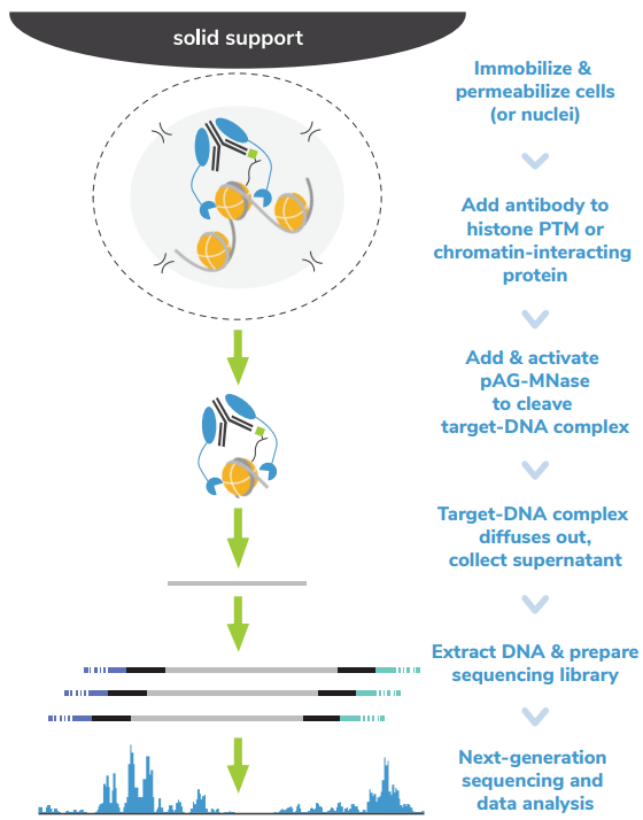
FIGURE 1?Overview of the CUTANA? CUT&RUN protocol.
ChIP-seq是組蛋白PTMs和染色質(zhì)相關(guān)蛋白全基因組定位的主要方法���。在這種方法中��,染色質(zhì)通過超聲或酶消化破碎���,然后免疫沉淀目標(biāo)特異性片段。盡管進行優(yōu)化�,但ChIP-seq需要大量細(xì)胞(通常為105?- 106個細(xì)胞)而且需要深度測序input 染色質(zhì)與免疫沉淀物質(zhì)(通常為?>3000萬?reads/次)來從背景中解析信號。
ChIC和CUT&RUN通過將基因組片段靶向釋放到溶液中���,徹底改變了染色質(zhì)調(diào)控����。通過這一創(chuàng)新���,背景顯著減少���,允許使用少量細(xì)胞且每個反應(yīng)僅需300 - 800萬reads/次對組蛋白PTMs和染色質(zhì)相關(guān)蛋白進行高分辨率基因組圖譜的繪制(Figure 2)�����。簡化的工作流程和節(jié)省的成本使ChIC/CUT&RUN適用于高通量研究表觀遺傳生物學(xué)����。
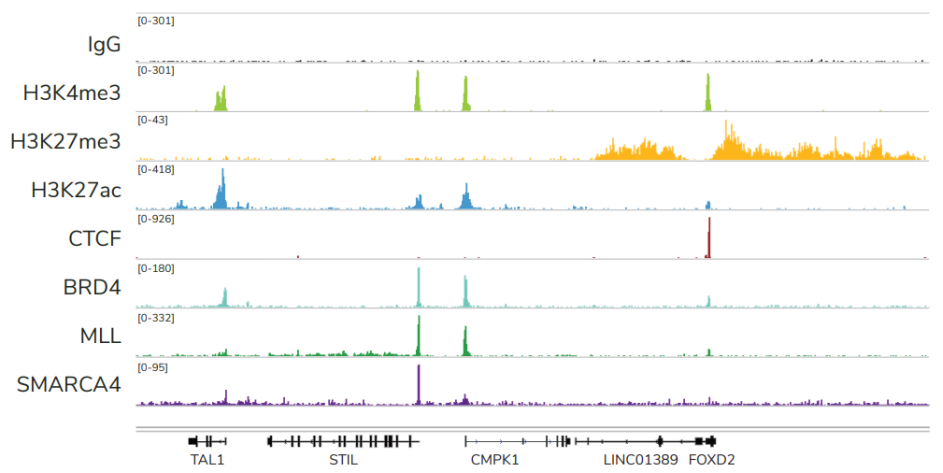
FIGURE 2 Representative genome browser tracks show CUTANA? CUT&RUN results using 500,000 K562 ??cells. ?Clear peaks with the expected distribution profile are observed using 3-8 million sequencing ?reads per reaction for a variety of epigenetic targets, including histone PTMs (H3K4me3, H3K27me3, ?H3K27ac), transcription factors (CTCF), epigenetic reader proteins (BRD4), writer enzymes (MLL1), ??and chromatin remodelers (SMARCA4). ?Rabbit IgG antibody shown as a negative control (top track).
?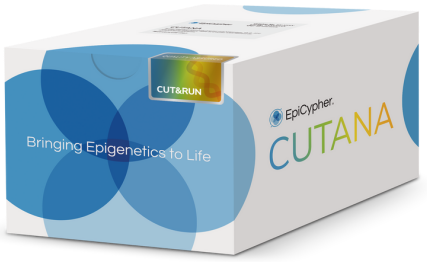
CUTANA?ChIC/CUT&RUN試劑盒包含48個反應(yīng)的材料���,專為多通道移液而設(shè)計���,以實現(xiàn)CUT&RUN的高通量優(yōu)勢。該試劑盒包括陽性(H3K4me3)和陰性(Rabbit?IgG)對照抗體�����,以及SNAP-CUTANA? K-MetStat Panel?(16個DNA條形碼設(shè)計核小體攜帶廣泛研究的賴氨酸甲基化PTMs)的分裝分量�。K-MetStat Panel加入到對照反應(yīng)中,直接監(jiān)測實驗成功與否并幫助排除故障��。此外���,在pAG-MNase切割后���,將剪切的E. coli?DNA添加到所有反應(yīng)中,以控制文庫構(gòu)建并使NGS標(biāo)準(zhǔn)化�。該試劑盒與細(xì)胞和細(xì)胞核兼容,包括凍存和交聯(lián)樣品(Figure 3)����。
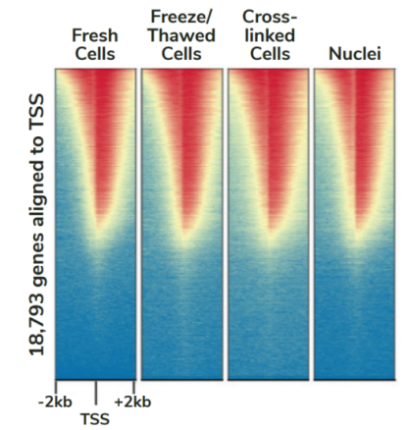
FIGURE 3 Heatmaps show CUT&RUN signal (red) and background (blue) of H3K4me3-enriched regions flanking annotated transcription start sites (TSS, +/- 2 kb). Gene rows are aligned across conditions, showing that genome-wide enrichment is preserved across sample types.
盡管建議從500,000個細(xì)胞開始,但只需使用5,000個細(xì)胞即可生成可比較的數(shù)據(jù)(Figure 4)�。對照組的加入以及與不同靶類型、樣本和低細(xì)胞數(shù)的兼容性�,使該試劑盒成為染色質(zhì)圖譜實驗的首選解決方案。? ? ? ? ? ? ? ? ? ? ? ? ? ? ? ? ?

FIGURE 4 Representative genome browser tracks for H3K4me3 (low abundance target) and H3K27me3 ?(high abundance target) CUT&RUN experiments using decreasing amounts of K562 cells. At 5,000 ??cells, data quality is largely indistinguishable from standard conditions (500,000 cells).
保存條件
OPEN KIT IMMEDIATELY?and store components at room temperature, 4℃, and -20℃ as indicated?(see User Manual corresponding to Kit Version 3). Stable for 6 months upon date of receipt.
Room Temperature (RT) | 4℃ | -20℃ |
8-strip Tubes | ConA Beads | 5% Digitonin |
DNA Cleanup?Columns | E. coli Spike-in DNA | 1 M Spermidine |
DNA Collection?Tubes | Bead Activation?Buffer | SNAP-CUTANA? K-MetStat Panel |
0.5 M EDTA | Pre-Wash Buffer | H3K4me3 Positive?Control Antibody |
100 mM Calcium Chloride | Stop Buffe | Rabbit IgG Negative?Control Antibody |
DNA Binding Buffer |
| pAG-MNase |
DNA Wash Buffer |
|
|
DNA Elution Buffer |
|
|
數(shù)據(jù)示例
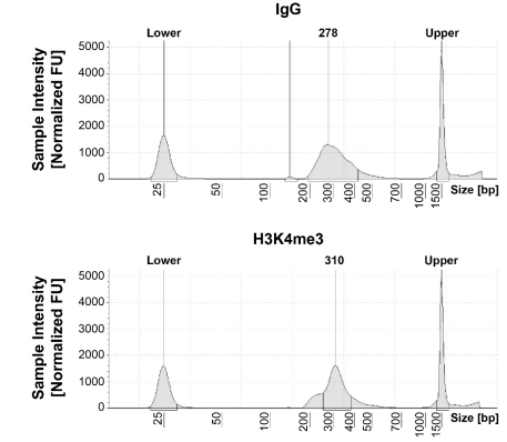 |
FIGURE 1: CUT&RUN DNA fragment size ?distribution analysis. ?CUT&RUN was performed ?as described above. ? Library DNA was analyzed ?by Agilent Tapestation? . ?This analysis confirmed ?that mononucleosomes? were predominantly ?enriched in CUT&RUN (~300 bp peaks represent 150 bp nucleosomes + sequencing? adapters). |
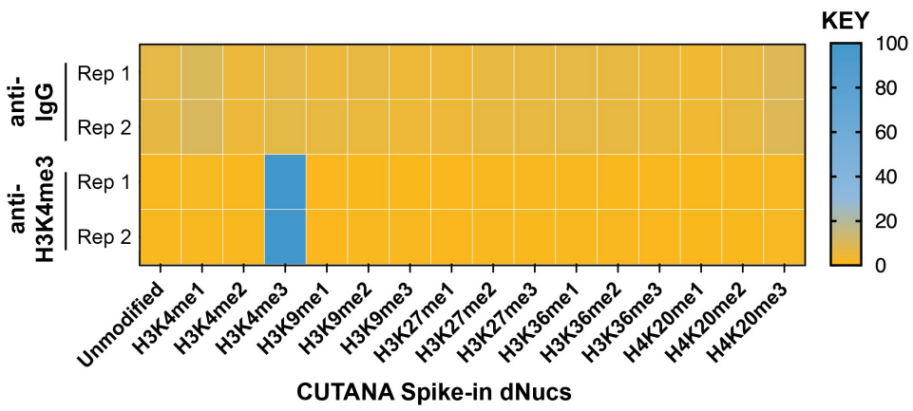 |
FIGURE 2: SNAP-CUTANA??K-MetStat Spikein Controls. DNA-barcoded designer ?nucleosomes (dNucs)? representing 16 K-methyl PTMs: mono-, di-, and tri-methylation at H3K4, H3K9, H3K27, H3K36,? and H4K20, as well as ?unmodified control, were spiked into CUT&RUN ?reactions prior to the? addition of antibodies (IgG, H3K4me3). Spike-in barcodes were counted and ?normalized from? raw fastq files using the shell ?script and analysis sheet available at ?epicypher.com/19-1002.? Barcodes for IgG (top; ?normalized to total reads) and H3K4me3 (bottom; normalized to on-target)? antibodies are ?shown. The spike-ins confirmed optimal ?experimental conditions (H3K4me3? antibody ?specifically recovered the target dNuc, while IgG ?showed no preferential enrichment). |
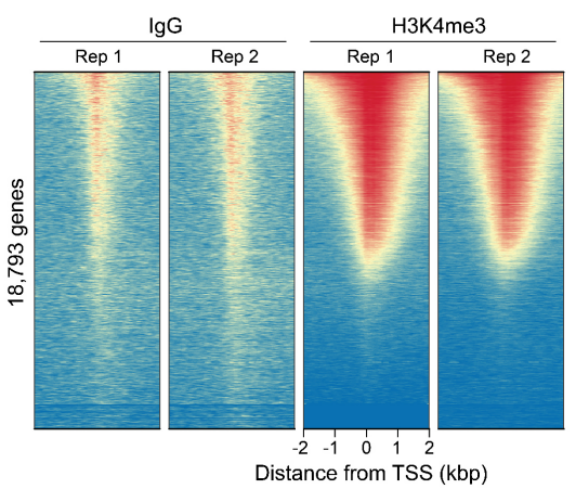 |
FIGURE 3: CUT&RUN genome-wide heatmaps. CUT&RUN was performed as described above. Peaks were? called with MACS2. Heatmaps show ?two replicates (“Rep”) of IgG (left) and H3K4me3 (right) kit? control antibodies in aligned rows ?ranked by intensity (top to bottom) and colored ?such that red? indicates high localized enrichment ?and blue denotes background signal. |
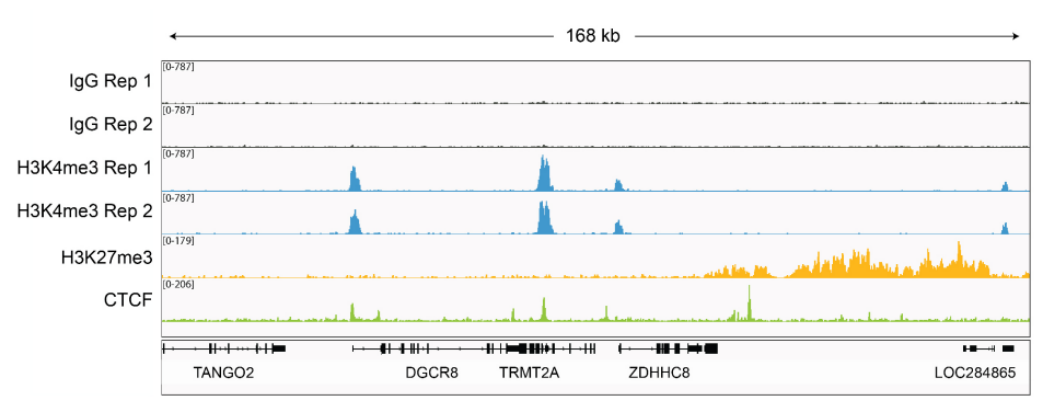 |
FIGURE 4: Representative gene browser tracks. CUT&RUN was performed as described above. A representative? 168 kb window at the TRMT2A gene is shown for two replicates (“Rep”) of IgG and H3K4me3 kit control ? antibodies. Representative tracks are also ?shown for antibodies to H3K27me3 and the ?transcription? factor CTCF. The CUT&RUN kit ?produced the expected genomic distribution for ?each target. Images? were generated using the Integrative Genomics Viewer (IGV, Broad Institute). |
訂購詳情
貨號 | 產(chǎn)品名稱 | 規(guī)格 |
14-1048 | CUTANA? ChIC/CUT&RUN Kit | 48 Reactions |
?

如需了解更多詳細(xì)信息或相關(guān)產(chǎn)品���,請聯(lián)系EpiCypher中國授權(quán)代理商-欣博盛生物?
全國服務(wù)熱線: 4006-800-892 ? ? ??郵箱: market@neobioscience.com?
深圳: 0755-26755892 ? ? ? ??北京: 010-88594029 ???????????
廣州:020-87615159????????? ?上海: 021-34613729
代理品牌網(wǎng)站: www.yuebanme.com?
自主品牌網(wǎng)站: www.neobioscience.net